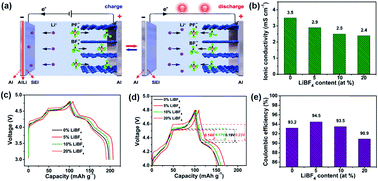Hybridizing anions towards fast diffusion kinetics for tri-ion batteries with significantly improved rate capability and cycling life†
Abstract
Dual-ion batteries are promising candidates for next-generation energy storage devices due to their merits of low cost, environmental friendliness and easy recovery. However, intercalation/deintercalation of large anions usually causes slow ion diffusion kinetics and large volume variation in graphite cathodes leading to unsatisfactory rate capability and poor cycling stability. Herein, we report a new aluminum–graphite tri-ion (Li+/PF6−/BF4−) battery configuration (named as AGTIB) using an anion-hybridization strategy by combining PF6− with BF4− in the electrolyte. An optimized AGTIB is demonstrated to exhibit fast ion diffusion kinetics and substantially reduced volume changes in the graphite cathode during cycling. The AGTIB has a high rate performance with a 90.5 mA h g−1 capacity at 15C (92.5% retention compared to 2C) and good cycling stability for over 500 cycles at 5C with negligible capacity decay. The present finding suggests that the facile anion hybridization strategy shows promising application for exploring high-performance energy storage devices.

- This article is part of the themed collection: 2019 Journal of Materials Chemistry A HOT Papers


 Please wait while we load your content...
Please wait while we load your content...